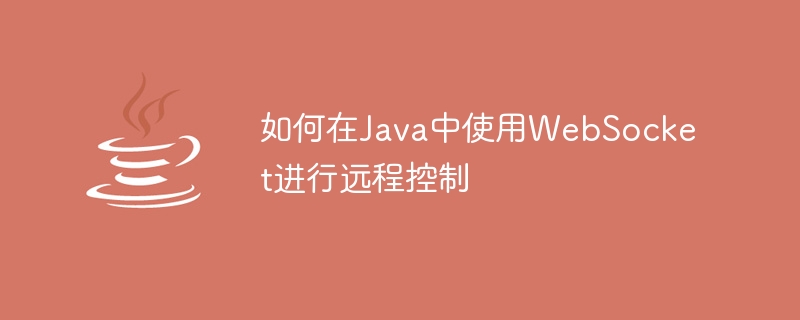

How to use WebSocket for remote control in Java
Overview:
With the popularity of the Internet and the continuous advancement of technology, remote control has become many application scenarios One of the most common requirements. As a full-duplex communication protocol, WebSocket has the characteristics of real-time and high efficiency, and is widely used to implement remote control functions. In the Java language, we can use some libraries and frameworks to simplify the development of WebSocket. This article will introduce how to use WebSocket for remote control in Java and provide some specific code examples.
Step 1: Introduce WebSocket libraries and frameworks
In order to use WebSocket for remote control, we first need to introduce relevant libraries and frameworks. In Java, commonly used WebSocket libraries include Tomcat's WebSocket API, Jetty's WebSocket API, etc., while WebSocket frameworks include Spring WebSocket, Atmosphere, etc. Choose a suitable library or framework according to your own needs and preferences, and configure and introduce it accordingly in the project.
Step 2: Implement the WebSocket server
The WebSocket server is responsible for receiving and processing client requests and sending data to the client. First, we need to define a WebSocket server-side class, which needs to implement the relevant interfaces of WebSocket (if using the Tomcat WebSocket API, implement the javax.websocket.Endpoint interface).
The following is a sample code for a simple WebSocket server-side class:
import javax.websocket.*;
import javax.websocket.server.ServerEndpoint;
@ServerEndpoint("/control") // 指定WebSocket的路径
public class RemoteControlServer {
@OnOpen
public void onOpen(Session session) {
// 处理客户端连接建立的逻辑
}
@OnMessage
public void onMessage(String message, Session session) {
// 处理客户端发送的消息
}
@OnClose
public void onClose(Session session) {
// 处理客户端连接关闭的逻辑
}
@OnError
public void onError(Throwable t) {
// 处理WebSocket异常
}
}In the above code, @ServerEndpoint("/control") specifies the path of WebSocket to /control, which means that the client You need to connect to the WebSocket server through ws://hostname:port/control.
Step 3: Implement remote control logic
The WebSocket server is only responsible for receiving and sending data, and the specific remote control logic needs to be implemented in the application. According to actual needs, we can define some methods or interfaces to handle specific remote control commands. The following is a sample code of a simple remote control logic:
public class RemoteControlLogic {
public void processCommand(String command) {
if ("start".equals(command)) {
// 处理启动命令
start();
} else if ("stop".equals(command)) {
// 处理停止命令
stop();
} else if ("restart".equals(command)) {
// 处理重启命令
restart();
} else {
// 处理其他命令
// ...
}
}
private void start() {
// 启动远程控制逻辑
}
private void stop() {
// 停止远程控制逻辑
}
private void restart() {
// 重启远程控制逻辑
}
}In the above code, we define a RemoteControlLogic class, in which the processCommand method is used to process remote control commands sent by the client. According to different commands, we can call different methods to perform corresponding logic.
Step 4: Process WebSocket messages
In the onMessage method on the WebSocket server side, we can pass the message sent by the client to the processCommand method of the remote control logic for processing. The following is a sample code:
@OnMessage
public void onMessage(String message, Session session) {
RemoteControlLogic logic = new RemoteControlLogic();
logic.processCommand(message);
}In this way, when the client sends a message to the server, the server will pass the message to the remote control logic to perform the corresponding operation.
Step 5: Implement the client
Implementing the WebSocket client also requires the use of corresponding libraries and frameworks. In Java, we can use the WebSocket API provided by Java EE, or use some third-party libraries, such as Java-WebSocket. Here, we take the Java-WebSocket library as an example to implement a simple WebSocket client.
The following is a sample code for a WebSocket client:
import org.java_websocket.client.WebSocketClient;
import org.java_websocket.handshake.ServerHandshake;
import java.net.URI;
import java.net.URISyntaxException;
public class RemoteControlClient extends WebSocketClient {
public RemoteControlClient(String serverUrl) throws URISyntaxException {
super(new URI(serverUrl));
}
@Override
public void onOpen(ServerHandshake handshake) {
// 连接建立后的逻辑
}
@Override
public void onMessage(String message) {
// 处理服务器端发送的消息
}
@Override
public void onClose(int code, String reason, boolean remote) {
// 连接关闭后的逻辑
}
@Override
public void onError(Exception ex) {
// 处理WebSocket异常
}
}In the above code, we define a RemoteControlClient class, inherit WebSocketClient, and override some methods to handle WebSocket events.
The above are the basic steps and code examples for using WebSocket for remote control in Java. Through the above steps, we can implement a simple remote control function. Of course, in actual application scenarios, we may also need to consider some issues such as security, performance, and scalability. However, the sample code provided in this article can be used as a starting reference and help readers start to understand how to use WebSocket for remote control in Java.
The above is the detailed content of How to use WebSocket for remote control in Java. For more information, please follow other related articles on the PHP Chinese website!
